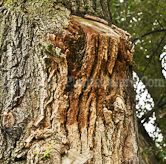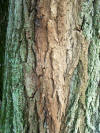|
 |
|
 |
|
 |
 |
 The most common cause of this problem
is an infection caused by several species of bacteria
including Enterobacter, Klebsiella and
Pseudomonas. The infection causes a buildup of
pressure from fermented sap that pushes out of
cracks in the bark. It is a chronic disease which may be
with the tree for decades. The most common cause of this problem
is an infection caused by several species of bacteria
including Enterobacter, Klebsiella and
Pseudomonas. The infection causes a buildup of
pressure from fermented sap that pushes out of
cracks in the bark. It is a chronic disease which may be
with the tree for decades.
|
 |
|
 |
 |
 In the spring, a slimy, sour smelling
ooze seeps from the bark of certain trees. Later, the
ooze dries and forms a permanent, gray colored stain on
the bark of the tree. Members of the Elm (Ulmus) genus
are probably the most common trees to be infected by
wetwood. In fact, one of the identifying features of
elms is that you can see the gray bark stain leading
down from the crotch of the tree from a distance. In the spring, a slimy, sour smelling
ooze seeps from the bark of certain trees. Later, the
ooze dries and forms a permanent, gray colored stain on
the bark of the tree. Members of the Elm (Ulmus) genus
are probably the most common trees to be infected by
wetwood. In fact, one of the identifying features of
elms is that you can see the gray bark stain leading
down from the crotch of the tree from a distance.
|
 |
 |
 |
The only way to prevent this problem is to avoid growing
susceptible species of plants.
Members of the Elm (Ulmus) genus
are probably the most common trees to be infected by
wetwood.
|
 |
 |
 |
There are no chemical controls for this
condition. To relieve some of the internal pressure,
some arborists will bore a small hole in the bark on an
upward direction toward the seeping area. They will
insert a 1/2 inch diameter
copper or plastic tube into
the hole to carry the ooze away from the bark. Of
course, since you are dealing with a bacterial
infection, all tools should be disinfected with alcohol
before using them on another plant.
|
 |
|
 |
|
Note: We
have provided some general information and
observations on this topic aimed at the home
gardener. Before you take
any serious action in your landscape, check
with your state's land grant university's
Cooperative
Extension
Service for the most current,
appropriate, localized recommendations. |
|
 |



